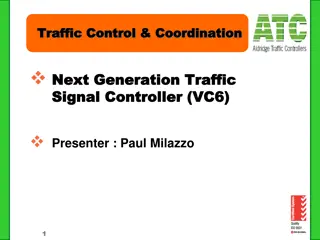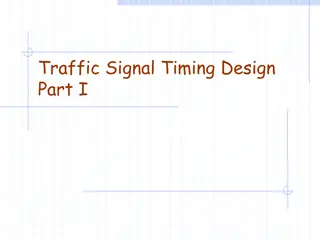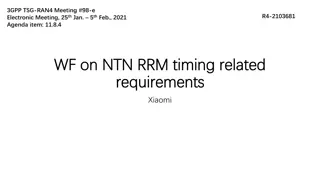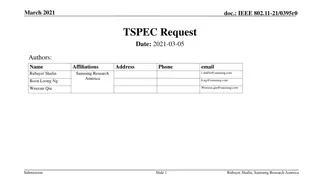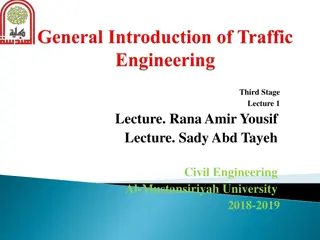An Overview of Traffic Signal Timing Planning
Understanding the process of designing a traffic signal timing plan involves determining lane configurations, proposing phase plans with diagrams, analyzing critical volumes, recommending a phase plan, and incorporating clearance intervals. Key concepts include considering shared LT+TH lanes, using left turn equivalents for volume allocation, and addressing impacts of LT phases on critical volumes. Through a full example scenario, the importance of factors like lost time, cycle length, and green splits are illustrated.
Download Presentation

Please find below an Image/Link to download the presentation.
The content on the website is provided AS IS for your information and personal use only. It may not be sold, licensed, or shared on other websites without obtaining consent from the author.If you encounter any issues during the download, it is possible that the publisher has removed the file from their server.
You are allowed to download the files provided on this website for personal or commercial use, subject to the condition that they are used lawfully. All files are the property of their respective owners.
The content on the website is provided AS IS for your information and personal use only. It may not be sold, licensed, or shared on other websites without obtaining consent from the author.
E N D
Presentation Transcript
Signal Timing: Putting it All Together
Steps in Designing a Traffic Signal Timing Plan (1/2) 1. Determine lane configurations and lane volumes 2. Propose Phase Plans (provide diagrams) 3. Critical Volumes for each phase (for each proposed plan) 4. Recommend phase plan 5. Clearance Intervals Slide 2
Steps in Designing a Traffic Signal Timing Plan (2/2) 6. Lost Time 7. Cycle length 8. Green Splits 9. Display Greens 10. Provide Final Timing Diagram Repeat as needed for other lane configurations. Slide 3
Critical Concepts to Note Shared LT+TH lanes Use of left turn equivalents for lane volume allocation LT phase impact on critical lane volumes Overlapping phasing: exception to the highest volume is critical rule Every intersection is different in terms of which phase plan works best Slide 4
Full Example Speed = 40 mph LT 1 00 TH 300 RT 1 50 LT 200 TH 400 RT 80 SB W B tr= 1 s s=1850 vphpgpl a=10 ft/s2 start and end loss = 3 s 11 foot lanes 24 foot vehicles LT 390 TH 500 RT 1 50 LT 50 TH 200 RT 200 EB NB Slide 5
Steps in Designing a Traffic Signal Timing Plan 1. Determine lane configurations and lane volumes 2. Propose Phase Plans (provide diagrams) 3. Critical Volumes for each phase (for each proposed plan) 4. Recommend phase plan 5. Clearance Intervals Slide 6
Full Example 480 200 LT 1 00 TH 300 RT 1 50 LT 200 TH 400 RT 80 SB W B NB & SB Exclusive LT lane Single shared TH & RT lane LT 390 TH 500 RT 1 50 LT 50 TH 200 RT 200 EB NB 390 650 Slide 7
Full Example 480 200 LT 1 00 TH 300 RT 1 50 LT 200 TH 400 RT 80 SB W B WB 1. Opposing traffic to LT EB TH+RT=200+200=400 2. 1 LT =2 TH 3. Total equivalent TH 300+2(100)+150 = 650 4. Per lane 650/2 = 325 325 125 225 100 LT 390 TH 500 RT 1 50 LT 50 TH 200 RT 200 EB NB 390 650 Slide 8
Full Example 480 200 LT 1 00 TH 300 RT 1 50 LT 200 TH 400 RT 80 SB W B EB 1. Opposing traffic to LT WB TH+RT=300+150=450 2. 1 LT =2 TH 3. Total equivalent TH 200+2(50)+200 = 500 4. Per lane 500/2 = 250 325 125 225 50 100 150 200 250 LT 390 TH 500 RT 1 50 LT 50 TH 200 RT 200 EB NB 390 650 Slide 9
Steps in Designing a Traffic Signal Timing Plan 1. Determine lane configurations and lane volumes 2. Propose Phase Plans (provide diagrams) 3. Critical Volumes for each phase (for each proposed plan) 4. Recommend phase plan 5. Clearance Intervals Slide 10
Phase Plans for EB/WB Slide 11
Steps in Designing a Traffic Signal Timing Plan 1. Determine lane configurations and lane volumes 2. Propose Phase Plans (provide diagrams) 3. Critical Volumes for each phase (for each proposed plan) 4. Recommend phase plan 5. Clearance Intervals Slide 12
Phase Plans for EB/WB Max {(325+50),(250+100)} = 375 Note: Unopposed LT, new lane volumes EB Total equivalent TH 200+1.1(50)+200 = 455 or 228/lane 228 280 = 508 WB Total equivalent TH 300+1.1(100)+150 = 560 or 280/lane Slide 13
Steps in Designing a Traffic Signal Timing Plan 1. Determine lane configurations and lane volumes 2. Propose Phase Plans (provide diagrams) 3. Critical Volumes for each phase (for each proposed plan) 4. Recommend phase plan 5. Clearance Intervals Slide 14
Phase Plans for NB / SB Slide 15
Steps in Designing a Traffic Signal Timing Plan 1. Determine lane configurations and lane volumes 2. Propose Phase Plans (provide diagrams) 3. Critical Volumes for each phase (for each proposed plan) 4. Recommend phase plan 5. Clearance Intervals Slide 16
Phase Plans for NB / SB Max {(480+390), (650+200)} = 870 Min {200,390} 190 (390-200) Max {390,200} Max {480,460} Max {650,480} CV= 870 CV= 1040 Slide 17
Steps in Designing a Traffic Signal Timing Plan 1. Determine lane configurations and lane volumes 2. Propose Phase Plans (provide diagrams) 3. Critical Volumes for each phase (for each proposed plan) 4. Recommend phase plan 5. Clearance Intervals Slide 18
Steps in Designing a Traffic Signal Timing Plan 1. Determine lane configurations and lane volumes 2. Propose Phase Plans (provide diagrams) 3. Critical Volumes for each phase (for each proposed plan) 4. Recommend phase plan 5. Clearance Intervals Slide 20
EB/WB Clearance Interval 1 = tr + [u0 /(2a)] + [(W+L)/u0] W is road width to be cleared (ft or m) = L is vehicle length (ft or m) = u0 is approach speed of vehicles (f/s or m/s) = tr is driver s reaction time (sec) = a is deceleration rate (ft/s2 or m/s2) = Slide 21
Steps in Designing a Traffic Signal Timing Plan 6. Lost Time 7. Cycle length 8. Green Splits 9. Display Greens 10. Provide Final Timing Diagram Repeat as needed for other lane configurations. Slide 24
Lost Time L = start/end loss + AR Slide 25
Steps in Designing a Traffic Signal Timing Plan 6. Lost Time 7. Cycle length 8. Green Splits 9. Display Greens 10. Provide Final Timing Diagram Repeat as needed for other lane configurations. Slide 26
Optimum Cycle Length 1.5 L + 5 Co = = 1- yi Slide 27
Steps in Designing a Traffic Signal Timing Plan 6. Lost Time 7. Cycle length 8. Green Splits 9. Display Greens 10. Provide Final Timing Diagram Repeat as needed for other lane configurations. Slide 28
Green Splits CV1 375 CV2 870 gT = C - L gi = gT (yi / Y) Slide 29
Steps in Designing a Traffic Signal Timing Plan 6. Lost Time 7. Cycle length 8. Green Splits 9. Display Greens 10. Provide Final Timing Diagram Repeat as needed for other lane configurations. Slide 30
Display Greens Gi = gi + li - i G1 = 12.8 + (3+0.6) - 4.1 = 12.3 seconds G2 = 29.8 + (3+0.8) - 4.3 = 29.3 seconds Slide 31
Steps in Designing a Traffic Signal Timing Plan 6. Lost Time 7. Cycle length 8. Green Splits 9. Display Greens 10. Provide Final Timing Diagram Repeat as needed for other lane configurations. Slide 32
Timing Diagram Slide 33






